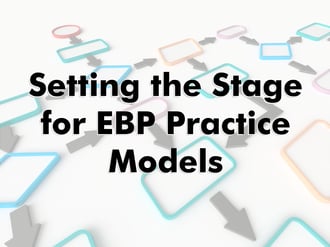This is the first installment of the blog series, Setting the Stage for EBP Practice Models with Brad Bogue, Evan C. Crist, Psy.D., Matt Moore and Tom O’Connor.
You may be wondering, “what the heck is a ‘Practice Model’?”
Or if you have been exposed to the term somewhere previously might be thinking, “Yeah, I’d like to see how all this works, or how it turns out to benefit me?”
And for those of you still struggling to make sense of even one evidence-based practice (e.g., cognitive skill-building, Motivational Interviewing, role clarification, relapse prevention, etc.), you probably have conflicted feelings about seriously committing to mastering that particular EBP, this thought piece may offer a key.
First, let’s define what a practice model is:
A practice model describes in detail the practices that line staff should follow to prevent more crime and promote the social and human capital (rehabilitation) of people under supervision.
A practice model is an integrated set of evidence-based practices and principles (EBP) that, when implemented with fidelity by the agency and its officers, will result in desirable public safety outcomes.
If this is new information to you, don’t be alarmed.
This is New
Practice models (PMs) haven’t been around the fields of community supervision or corrections very long.
The first PMs started emerging in the US and other countries a little less than ten years ago. Now there are at least a handful of off-the-shelf models. These Practice Models have been researched, written about and are available to interested agencies.
You may have heard of these more popular models including:
- Strategic Training Initiative for Community Supervision (STICS)
- Effective Practices In Community Supervision (EPICS)
Other models include:
- IBIS
- ESP
- STARR
- Vogelvang
- COMBINES
The latter models, with two possible exceptions (ESP, known as the Ramsey County Community Corrections model, and Vogelvang) were primarily developed and designed by researchers; the classic research-to-practice approach.
Should Practice Influence Research or Vice Versa?
Arguably, research-to-practice has been the primary thrust for introducing scientifically vetted programs into the field.
While the research supporting some of the above programs is quite significant and promising, there still exist many inherent problems when moving something designed afar afield, in academia so to speak, to the field. Not the least of which is the resistance that can arise when line staff believe their skills and expertise are being ignored.
Just as the quality of offender assessments depends on the skills of the staff member conducting it, practice models, at the end of the day, depend on the quality of the skills of the team members using the model.
The Hand That Turns the Screw
Shouldn’t front line staff be engaged in co-creating their own practice models? Wouldn’t you agree that it would avoid any undermining of motivation and pride on the line?
There is a name for this strategy: practice-to-research.
As it turns out, when experienced staff members are invited to reverse engineer some of the above practice models, they do a pretty darn good job of identifying the glitches and gaps in these models.
Moreover, staff members readily identify some of the tricks and practices that are supportive, or in some cases key causal ingredients of offender change that have yet to make their way into the research.
What are the hurdles?
It seems that the most instrumental conflicts in this process are:
- Staff members must trust that management will honor their decision-making and design input and that the results will be utilized.
- The overarching framework or organizing principle / mechanism is explicitly articulated to guide the development and use of the resulting model.
The first issue is arguably an adaptive (gnarly, alive and capable of fighting back) change issue, and the latter is a technical issue. Both are worth exploring.
First, for management to promote employee buy-in and trust, it can be helpful to begin shifting responsibility for the design of more processes to the line staff. In particular, frontline staff could be involved in decisions about which EBPs are to be incorporated into your agency’s respective way of doing business, i.e., your practice model. It can also be helpful to encourage staff to identify and vet other tactics that might belong in the team’s model, even if they may not necessarily be associated with EBPs yet. By doing this, the agency begins to learn more about and tap into the tremendous tactical knowledge staff members carry around.
There is a process for holding the above types of conversations and initiating dialogue with staff, developed by Bas Vogelvang, a criminologist in the Netherlands who’s specialty is working with line officers. The name of this process for structuring staff meetings is the Building Block Model and we’ll provide more on this in an upcoming blog.
This is Just the Beginning
To learn about the technical piece of designing how a given set of EBPs becomes integrated into practice at deeper levels, check out our practice model presentation from APPA.
There are actually many ways of integrating various EBPs into a model or framework.
The one we presented seems to have the advantage of being very concrete on one hand, with step-by-step procedures. And yet on the other hand, it is also extremely flexible and can readily adapt from one agency situation to another.
We intend to have considerable discussions about both the adaptive and the technical change aspects of practice models in the future.
We’d love to hear from you.
I, along with Evan, Matt and Tom, want to continue this blog series by delivering information that YOU want to learn. Click here or comment below to leave us questions, comments and requests for more information on EBP practice models.


